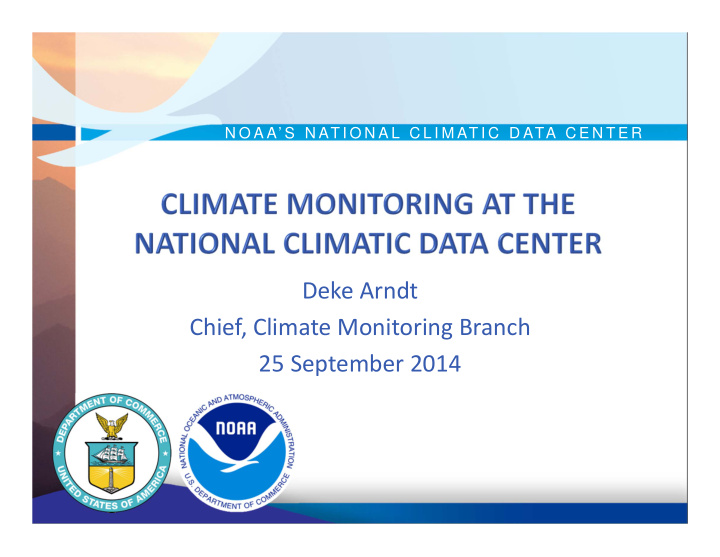



N O A A’ S N AT I O N A L C L I M AT I C D ATA C E N T E R Deke Arndt Chief, Climate Monitoring Branch 25 September 2014
2 Asheville, NC (and points beyond!) since early 1950s Climate Monitoring Branch established 1998 • Mission: “monitor and assess the state of the climate” • We deal in data – the observed climate. • This complements, informs and draws from larger climate science (the understood climate)
3 Simply, climate monitoring is the scorekeeping, play by play, and analysis of the climate system Must know the game (know the climate system) • Must know the score (have the data) • Must know which stats matter most (who uses what and when) • Must know the specific, and many, needs of the “audience” •
“Great energy springs from a correspondingly great tension of opposites.” 4 Science Decision ‐ Support Timeliness Precision Things measured Things Counted In situ measures remote/satellite measures Spatial Scale Temporal Scale Type of Observing Platform
5 Support Science: • Verification/assessment • Helps us better understand the climate system • Helps us evaluate our understanding of same Support Decisions and Analyses: • Helps the market better understand external climate/weather ‐ related drivers • Helps the market (which is huge and made of many markets) better understand its own behavior
6 Annual connection with broader and longer ‐ term state of the climate system Technical dive: hundreds of variables, places and phenomena Atmospheric, Upper ‐ Air, Oceanic, Deep Ocean, Cryosphere, Terrestrial • Part of a larger body of periodic assessments Published by American Meteorological Society; led by NCDC • 420+ authors from 50+ countries • http://www.ncdc.noaa.gov/bams ‐ state ‐ of ‐ the ‐ climate •
7
8 I was driving 41 miles per hour More CONTEXT The speed limit was 25 mph In an alley In a school zone With kids everywhere I was accelerating
9 Approx. 58.5°F Approx. 1.2°F warmer than 20 th century average 3 rd warmest on record Record is 135 yrs August was 354 th consecutive month warmest than its 20 th century average
10 2014 through August Data from Climate at a Glance: http://www.ncdc.noaa.gov/cag
11 What happened? How different is that? How unusual is that? What is the trend? What are the impacts? (don’t forget variability) (don’t forget providing the data and provenance)
“You can’t know where you’re going until you know where you’ve been.” 12 Today’s observations need context. • How do we know our trajectory without it? Monitoring marries today’s observations with NCDC’s decades ‐ to ‐ centuries of data. This historical record – our context – is a gift from generations of observers, stewards, and data scientists
13 2014 through August Data from Climate at a Glance: http://www.ncdc.noaa.gov/cag
from Aug 2014 Global report: http://www.ncdc.noaa.gov/sotc/global
15 from Aug 2014 US report: http://www.ncdc.noaa.gov/sotc/national
“ Afternoon Highs ” “ Overnight Lows ” from Aug 2014 US report: http://www.ncdc.noaa.gov/sotc/national
17 This example: Residential Energy Demand Temperature Index Some others: • Heat Stress Index • Air Stagnation • Wind Behavior • Crop Moisture Stress Index http://www.ncdc.noaa.gov/societal-impacts/redti/
CLIMATE EXTREMES INDEX BILLION DOLLAR DISASTERS http://www.ncdc.noaa.gov/extremes/cei/ http://www.ncdc.noaa.gov/billions/
19 “Haywood Plots” often available with monthly reports: http://www.ncdc.noaa.gov/sotc/national
20 “Haywood Plots” often available with monthly reports: http://www.ncdc.noaa.gov/sotc/national
21 Wildfire folks not so concerned with this Reservoir managers very concerned “Haywood Plots” often available with monthly reports: http://www.ncdc.noaa.gov/sotc/national
22 We delayed our reports in early 2014 for logistical reasons. Here’s who we heard from: Private Sector: • Consulting meteorologists Retail (companies monitoring own sales, broader financial analysts) Finance (retail analysis, commodities) Manufacturing (lots of building interests) Big Agriculture Big Energy (and lots of little energy) Media (local, national, print, broadcast, electronic) Public Sector: • Fed: USDA, US Census Bureau, National Weather Service, US Army Corps of Engineers State, Local, Tribal Govt: state climatologists, state water managers Health researchers
23
24 No single system, institution, method will help everybody Climate is complex • A person is complex • Society is complex • Climate monitoring relies on partnerships State Climatologists • Regional Climate Centers • National Weather Service • Agencies (local, tribal, state, federal) • Observers • Science community • The private sector • International Weather / Oceanographic Services •
25 The U.S. Drought Portal is the public face of the National Integrated Drought Information System Drought.gov sits at NCDC, where ideas from partners and customers can be fused with the most direct access to the highest quality data. Coming Soon: gridded Standardized Precipitation & Evapotranspiration Index “How unusual has the combination of temperature and [lack of] precipitation been?”
IN ‐ SITU SATELLITE ‐ DERIVED (DEPTH OF RECORD) (BREADTH OF COVERAGE/SAMPLE)
27 What happened? How different is that? How unusual is that? What is the trend? What are the impacts? (don’t forget variability) (don’t forget providing the data and provenance)
N O A A’ S N AT I O N A L C L I M AT I C D ATA C E N T E R http://www.ncdc.noaa.gov/ http://www.ncdc.noaa.gov/climate ‐ monitoring Monthly reports: http://www.ncdc.noaa.gov/sotc US Time series info: http://www.ncdc.noaa.gov/cag
Recommend
More recommend